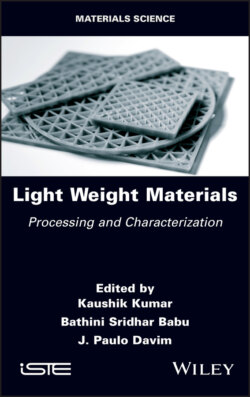Light Weight Materials

Реклама. ООО «ЛитРес», ИНН: 7719571260.
Оглавление
Группа авторов. Light Weight Materials
Table of Contents
List of Illustrations
List of Tables
Guide
Pages
Light Weight Materials. Processing and Characterization
Preface
1. Additive Manufacturing: Technology, Materials and Applications in Aerospace
1.1. Introduction
1.2. Additive manufacturing configuration
1.3. Classification of AM technology
1.3.1. Laser beam melting
1.3.2. Electron beam melting
1.3.3. Selective laser melting
1.3.4. Direct metal laser sintering
1.3.5. Laser metal fusion
1.3.6. Direct metal deposition
1.4. Materials used in AM technology
1.4.1. Titanium and its alloys
1.4.2. Inconel
1.4.3. Aluminum
1.4.4. Stainless steel
1.5. Aerospace applications of additive manufacturing
1.6. Challenges faced in the aerospace industry
1.7. Overcoming aerospace challenges with AM
1.8. Future work
1.9. Conclusion
1.10. References
1.11. Key terms and definitions
2. Study of the Manufacturing Process of Polymer Spur Gears: A Light Weight Gear Material
2.1. Introduction
2.2. Gear manufacturing process
2.2.1. Gear hobbing machine
2.2.2. Injection molding
2.3. Additive manufacturing/rapid prototyping
2.4. Laser ablation
2.5. Hot embossing
2.6. Conclusion
2.7. References
3. Recent Trends in Welding Polymers and Polymer–Metal Hybrid Structures
3.1. Introduction
3.2. Polymer and composites
3.3. Polymerization
3.4. Synthesis of polymer composites
3.5. Types of fillers in composites
3.5.1. Effect of reinforcement orientation
3.6. Welding polymers
3.7. Introduction of lightweight metal and alloys. 3.7.1. Magnesium alloys
3.7.2. Aluminum alloys
3.8. Welding dissimilar metal alloys
3.8.1. Friction stir welding
3.8.2. Welding polymer and metal alloys
3.8.2.1. Conventional resistance welding
3.8.2.2. Self-piercing rivet (SPR) technique (Kang et al. 2016)
3.9. Industrial application of polymers
3.10. Conclusion
3.11. References
4. Preparation and Characterization of a Composite Material Using Sisal fibers for Light Body Vehicles
4.1. Introduction
4.1.1. Statement of the problem
4.1.2. General objective
4.1.3. Specific objectives
4.1.4. Significance of the study
4.2. Literature review. 4.2.1. Introduction
4.2.2. Previous works on natural fiber polymer composites
4.3. Materials and methods
4.3.1. Sample preparation methods. 4.3.1.1. Sisal fiber-reinforced composite preparation
4.3.1.2. Materials required for the hand lay-up method
4.3.1.3. Cutting and arrangement of sisal fibers
4.3.1.4. Dimension of test specimens
4.4. Results and discussion. 4.4.1. Experimental results. 4.4.1.1. Tensile test
4.4.1.2. Compression test
4.4.1.3. Water absorption test
4.4.2. Observation
4.4.2.1. Fender
4.4.2.2. Fender fabrication
4.5. Comparison of previous works. 4.5.1. Tensile strength
4.5.2. Bending strength
4.6. Conclusion and recommendation
4.6.1. Recommendations for prospective applications
4.6.2. Scope for future work
4.7. References
5. Optimizing the Polystyrene Catalytic Cracking Process Using Response Surface Methodology
5.1. Introduction
5.2. Material and methods. 5.2.1. Materials
5.2.2. Experimental procedure and characterization
5.2.3. Design of catalytic cracking experiment using response surface methodology
5.3. Results and discussion. 5.3.1. Thermal analysis of polystyrene
5.3.2. SEM-EDX analysis
5.3.3. Model development for catalytic cracking of polystyrene
5.3.4. Combined effect of process parameters on the response (Y)
5.3.5. Characterization of liquid yield
5.3.6. Factors affecting catalytic cracking of polystyrene
5.4. Conclusion
5.5. References
6. FEA Comparative Studies on Heat Flux and Thermal Stress Analysis during Conduction Mode and Keyhole Mode in the Laser Beam Welding
6.1. Introduction
6.2. Heat in laser welding
6.3. Modeling
6.4. Results and discussion. 6.4.1. Keyhole model
6.4.2. Conduction model. 6.4.2.1. Temperature distribution
6.4.2.2. Residual stress analysis
6.5. Conclusion
6.6. References
7. Effect of Formability Parameters on Tailor-Welded Blanks of Light Weight Materials
7.1. Introduction
7.2. Experimental procedure
7.3. Results and discussion
7.4. Conclusion
7.5. References
8. Design and Analysis of Sedan Car B-pillar Outer Panel Using Abirbara with S-glass Fiber Hybrid Composites
8.1. Introduction
8.2. Materials and methods. 8.2.1. Materials
8.2.2. Methods
8.3. Composite preparation, testing and analysis. 8.3.1. Composite preparation
8.3.2. Testing and analysis
8.4. Design analysis of the B-pillar panel
8.5. Conclusion
8.6. Recommendations
8.7. Acknowledgments
8.8. References
List of Authors
Index
WILEY END USER LICENSE AGREEMENT
Отрывок из книги
Edited by
.....
AM is a versatile technology. Today, it has become the central building block of future hybrid manufacturing. The additive manufactured components are efficiently used in aerospace, automobile and biomedical industries.
Aboulkhair, N.T., Simonelli, M., Parry, L., Ashcroft, I., Tuck, C., and Hague, R. (2019). PMSP Aboulkhair 3D printing of aluminium alloys: Additive manufacturing of aluminium alloys using selective laser melting. Progress in Materials Science, 106, 100578.
.....